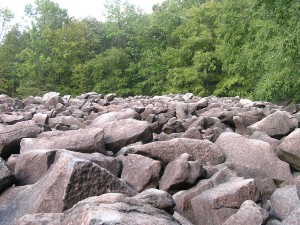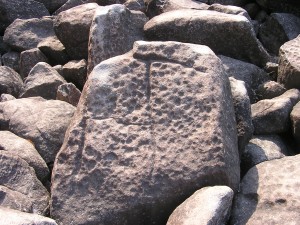Ringing Rocks A Geological and Musical Marvel
On a sticky day in late August as the heat wave of 2010 was waging one of its last battles against the thermometer, the Cestere family from Long Island was attending a rock concert at one of Bucks County’s oddest parks.
Actually, they were the concert.

Ringing Rocks Park consists of a seven-acre boulder field in a 128-acre Bucks County park in Upper Black Eddy.
Armed with hammers provided by the owner of the nearby campsite where they were spending the week, Joe Cestere, his wife, Doreen, and teenage daughters Jessica and Brittany spent the afternoon tapping out tunes on the various boulders at Ringing Rocks Park high above the Delaware River in Upper Black Eddy.
Hidden away off Bridgeton Hill Road about a half-mile from River Road, Ringing Rocks Park is a seven-acre field of ancient boulders that ring with various tones when struck with a hammer. The boulders sit about 10 feet deep, a short hike into the woods and the desolate field, isolated location and an almost complete lack of vegetation have given the site a legendary mystical appeal.
“I guess they were left over from glacier fields,” said Joe Cestere, adding that was the explanation provided by his campground owner. Castere agreed that it was an odd site. “It is different.”
“It’s eerie, off in the woods like that,” said daughter Brittany.
In the 1890s a Bucks County researcher named J J. Ott collected a variety of rocks with different tones and “played” them with hammers for the Buckwampum Historical Soceity, holding what might have been the world’s first real rock concert. In the 1960s a geologist named Richard Faas from Lafayette College in Easton found that the boulders also generated tones at frequencies too low for humans to hear during research that determined their composition, but the website www.unmuseum.org reported that Faas never really found the reason for the ringing.
The site has been featured in shows on the Travel, Learning and History channels, profiled by a variety of independent bloggers and has been associated with paranormal activity ranging from ley lines – mythical lines of force emanating from fault lines – to hauntings and UFO landings sites.

The site was considered sacred by the Lenni Lenape Indians and some believe it has mystical properties.
The truth is actually much more fascinating, according to a modern-day Lafayette College geology professor.
Dr. Larry Malinconico says the rocks are more than 200 million years old, and while they weren’t formed or deposited directly by glaciers, ice ages 100,000 years ago did help create the weird boulder field and contribute to their musical attributes.
The glaciers never really made it south of Blue Mountain, Malinconico said, but their impact on nearby weather helped move the rocks to the surface and break them up into a boulder field by the constant freeze and thaw created by that ancient environment.
The glaciers provided the water that broke up the 200 million year old igneous – volcanic – rocks that were part of the sill that eventually filled what was then known as the Newark Basin geologic formation during the Mesozoic Era. Once the basin stopped filling, the supercontinent known as Pangea started breaking up and the gaps were filled by a slow lava influx that created igneous rock.
That igneous became diabase, an iron-rich rock, which helps contribute to the ringing, Malinconico said.
“The water literally broke up the rocks into the pieces you see today at Ringing Rocks. There was no water flowing, it was just freezing and thawing,” he said. “The ringing is a function of the iron-rich composition and the fact that they sit on top of each other with hollow space in between them.”
As for Ringing Rocks, and why they are gathered at the top of the hill above the Delaware River, “It’s just a fortuitous area where the sill is deep enough that it collected this boulder field,” Malinconico said.
“It’s a fascinating geological story,” Malinconico said. “The weird stuff is fun, but the truth can also be fun.”
If You Go: Ringing Rocks Park is an official Bucks County Park. It can be reached by taking Route 611 south to Route 32-River Road and turning onto Bridgeton Hill Road. Go up past the Bridgeton Elementary School and turn right onto Ringing Rocks Road near the Bridgeton Athletic Association fields. Or you can take Route 611 north to Marienstein Road in Nockamixon Township at Ferndale and follow it till in becomes Bridgeton Hill Road, then turn left onto Ringing Rocks Road. The park is less than a half-mile down the road. Parking is limited.
What To Know: One trail leads to the boulder field. Sturdy hiking or walking shoes are recommended for climbing over the boulders. Another trail leads to Bucks County’s highest waterfalls.
Facts: Five miles north of Ringing Rocks Park are rocks that are about 500 million years old, and the rock beneath Lafayette’s College Hill in Easton is estimated to be 1 billion years old, Malinconico said.








It is interesting how geology faculty members keep re-discovering Ringing Rocks. Please see “Rock Music” in the 1970 December issue of Natural History.
Gordon, thanks for reading. I will try to find that issue.
Here’s an alternate suggestion for the catastrophic formation of this phenomena.
Ringing Rocks of Pottsgrove, PA, similar to the Ringing Rocks boulder field of Upper Black Eddy, PA. These rocks belong to a class of boulder fields with surface features such as pock marks, pot holes and linear striations scoured into the surface as if with a sand blaster. The culprit may be the relatively recent impact of a comet fragment traveling at speeds on the order of 10’s of km/s. Comets are known to contain phyllosilicates which in high-temperature and pressure aqueous slurries may fracture rock the way volcanic ash in stratovolcanos can blast away entire mountainsides.
An endothermic chemical reaction between H2O and CO2 ices (H2O + CO2 = hydrocarbons + O2) may absorb a majority of the kinetic energy in comet impacts and clamp the impact shock-wave pressure below the melting point of rock, and the impact pressure creates a compressed rind that apparently acts like an acoustic wave guide. Hickory Run boulder field also has boulders with similar scoured out surface features.
Blogroll
Categories
Archives
Meta
Most Commented
Tags